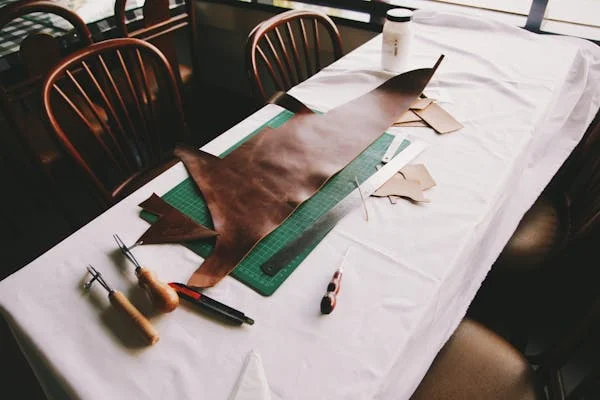Introduction
It is an innovative material that serves as an alternative to traditional leather. It is designed to replicate the appearance, texture, and durability of animal-based leather while being more sustainable and cruelty-free. With increasing environmental concerns and ethical considerations, industries are shifting toward sustainable materials like leatheling to reduce carbon footprints and animal exploitation.
Consumers today are more conscious about the impact of their purchases. Traditional leather production contributes to deforestation, excessive water consumption, and pollution due to tanning chemicals. This has led to the development of leatheling, a responsible choice for industries looking for durability, flexibility, and eco-friendliness without harming animals or the environment.
Understanding Leatheling: What Is It?
It is a composite material that combines natural and synthetic elements to mimic leather. Unlike genuine leather, which is derived from animal hides, leatheling is created using biodegradable or synthetic components. Some of the most common sources for leatheling include plant-based materials such as pineapple leaves, apple peels, mushroom mycelium, and cork. These natural fibers provide an organic feel while maintaining durability.
Another form of leatheling involves the use of recycled plastics blended with fabric fibers. This method helps reduce plastic waste while ensuring a strong and flexible material. Additionally, polyurethane (PU) and other polymers are often incorporated to enhance strength, making leatheling a reliable substitute for leather in fashion, furniture, and automotive industries.
The development of leatheling addresses environmental concerns associated with traditional leather production, such as deforestation, water pollution, and the use of harmful tanning chemicals. Its eco-friendly nature makes it a preferred choice for conscious consumers and manufacturers looking for sustainability without compromising on quality.
Composition and Manufacturing Process
The process of manufacturing leatheling varies depending on the source materials used. However, the core steps remain the same across different production methods.
1. Sourcing Raw Materials
The first step in the production of leatheling involves sourcing the necessary raw materials. These can include natural sources like plants and fruit waste or recycled synthetic materials such as plastics and rubbers. Sustainable farming and waste-reduction techniques are employed to ensure minimal environmental impact.
2. Processing and Refinement
Once the raw materials are collected, they undergo chemical or mechanical processing to extract fibers or resins. In plant-based versions, the fibers are carefully extracted, purified, and treated to improve durability. For synthetic options, plastics are melted down and blended with textile fibers.
3. Blending and Coating
The processed materials are then blended and formed into sheets that resemble leather. A special coating may be applied to improve waterproofing, UV resistance, or enhance the texture to make it feel like genuine leather.
4. Finishing and Coloring
To create a final product that mimics the look and feel of leather, the material is embossed, dyed, or textured. Non-toxic dyes and organic treatments are often used to maintain eco-friendliness while achieving the desired color and finish.
Physical and Mechanical Properties of Leatheling
It is designed to replicate the performance characteristics of traditional leather while offering unique benefits. The table below highlights its key physical and mechanical properties compared to genuine leather.
| Property | Leatheling | Traditional Leather |
| Texture | Soft, smooth, can mimic grain patterns | Natural grain, varies by animal type |
| Durability | Highly durable, resistant to cracking | Strong, but may degrade over time |
| Flexibility | Flexible, adapts well to different uses | Becomes stiffer with age |
| Water Resistance | Water-resistant or waterproof | Absorbs water unless treated |
| Breathability | Breathable, depending on material | Natural breathability |
| Eco-Friendliness | Highly sustainable | Resource-intensive production |
| Maintenance | Easy to clean and maintain | Requires conditioning and careful care |
Leatheling offers superior water resistance, making it a great choice for items exposed to moisture. Additionally, it is more sustainable and requires minimal maintenance compared to traditional leather, which needs conditioning to prevent cracks.
Advantages of Leatheling Over Traditional Leather
1. Environmental Sustainability
Leatheling is an environmentally friendly alternative to leather. Unlike traditional leather production, which involves deforestation, high water usage, and chemical-intensive tanning processes, leatheling is produced using sustainable practices. It reduces pollution and minimizes waste, making it a responsible choice for industries and consumers.
2. Ethical and Cruelty-Free
One of the biggest advantages of leatheling is that it does not require animal exploitation. Traditional leather is sourced from animal hides, leading to ethical concerns regarding animal cruelty. Leatheling, on the other hand, is 100% cruelty-free, making it an ideal option for vegans and individuals who advocate for animal rights.
3. Versatility and Customization
Leatheling can be produced in a variety of colors, textures, and finishes. Whether smooth, embossed, or patterned, manufacturers can customize the material to meet different industry needs. This versatility allows it to be used in fashion, furniture, and even automotive applications.
4. Cost-Effectiveness
While genuine leather can be expensive due to the tanning and processing required, leatheling is generally more affordable. Manufacturing processes allow for mass production at a lower cost while maintaining high-quality standards.
Applications of Leatheling
1. Fashion Industry
Leatheling is widely used in the fashion industry for making:
- Shoes: Durable and flexible, offering waterproof options.
- Bags and wallets: Stylish and cruelty-free accessories.
- Clothing: Jackets, pants, and belts designed with sustainable materials.
2. Automotive Sector
The car industry is adopting leatheling for:
- Car seats: Durable and weather-resistant upholstery.
- Steering wheels and dashboards: Provides a premium look without environmental drawbacks.
3. Interior Design and Furniture
- Sofas and chairs: High-end furniture brands are incorporating leatheling for eco-conscious customers.
- Wall coverings and flooring: Sustainable and easy to maintain.
4. Electronics and Accessories
- Phone cases, laptop covers, and watch straps: Sustainable alternatives to genuine leather.
Challenges and Limitations of Leatheling
1. Perception and Acceptance
Despite its advantages, many consumers still prefer traditional leather due to its natural feel and durability. Overcoming these perceptions requires education and awareness about the benefits of sustainable alternatives.
2. Material Limitations
Some plant-based versions may lack the same strength as genuine leather. Additionally, waterproofing treatments may reduce breathability, making certain types less suitable for specific applications.
3. Cost of High-Quality Versions
Although leatheling is generally more affordable, high-end sustainable versions can be expensive due to research and production costs.
Future Trends and Innovations in Leatheling
The future of leatheling looks promising with ongoing research and innovation. Scientists are developing lab-grown leather alternatives from fungal mycelium and plant proteins. Additionally, some companies are working on smart leatheling with embedded sensors or temperature control features. Luxury brands are increasingly adopting sustainable materials, paving the way for mass adoption in high-end markets.
Conclusion:
It represents a major step forward in sustainable materials. With increasing awareness about ethical fashion and environmental conservation, it is gaining popularity across various industries. While it may not completely replace traditional leather, its eco-friendliness, affordability, and versatility make it a viable option for consumers looking for a responsible alternative.
As research and innovation continue, we can expect further improvements in the quality and accessibility of leatheling, making it a mainstream choice in the future.
FAQs About Leatheling
What is leatheling made of?
It is made from natural and synthetic materials, such as plant fibers, fruit waste (pineapple leaves, apple peels), mushroom mycelium, cork, and recycled plastics.
Is leatheling better than real leather?
It offers advantages like being eco-friendly, cruelty-free, and water-resistant. However, traditional leather is still preferred by some for its natural texture and longevity.
Can leatheling be used for car interiors?
Yes, it is increasingly used in car interiors for seats, dashboards, and steering wheels due to its durability and sustainability.
How do you maintain leatheling products?
It is easy to maintain. Simply wipe it with a damp cloth and mild soap. Avoid excessive heat and direct sunlight to extend its lifespan.
Is leatheling waterproof?
Most types of leatheling are water-resistant or waterproof, depending on the material composition and protective coatings applied during manufacturing.
Where can I buy leatheling products?
It products are available in fashion stores, sustainable brands, online marketplaces, and eco-conscious furniture retailers.




